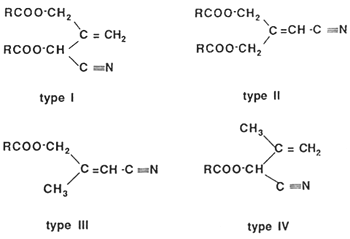
Cyanolipids represent an unusual class of lipids co-occurring in the seed oil of a limited number of plant families. They were first reported in 1920 to occur in Schleichera trijaga (Sapindaceae) seed oil but their structure was not elucidated.
The first established structure was that of cyanolipids (Type I) found in a borage (Cordia verbenacea, Boraginaceae) (Mikolajczk KL et al. Lipids 1969, 4, 617). Later, it has been shown that the occurrence of cyanolipids in plants is restricted to only a few families such as the Sapindaceae, the Hippocastaneaceae, Boraginaceae, and in some Leguminosae(Acacia).
Their basic structure includes the same branched five-carbon nitrile skeleton with variations in the number and position of the hydroxyl groups and double bonds.
Four types of cyanolipid structures (Types I-IV), with fatty acids (R) esterified to a mono- or a dihydroxy C5 nitrile moiety have been reported as occurring in Sapindaceae species (Paullinia sp., Allophylus sp., Nephelium sp., Sapindus sp., etc.) and to some extent genera can be classified according to the type of cyanolipid present.

These molecules consist of one or two 18- and 20-carbon fatty acids esterifying a mono- or diihydroxynitrile moiety. Cyanolipids I and IV can be regarded as esters of the HCN addition-product (cyanohydrin) of the aldehyde with one less carbon atom. On hydrolysis of the ester link, enzymatically or under acid action, the addition is reversed with the liberation of HCN (cyanogenesis), thus possibly providing a protective function for the plant (Selmar D et al., Plant Physiol 1990, 93, 631). It has also been suggested that these compounds may serve in vivo as a major nitrogen source for developing seedlings (Selmar D et al., Plant Physiol 1990, 93, 631). The other two types (2 and 3) are not cyanogenic.
Compositional studies on cyanolipids have indicated that they are characterized by a particular high content of one C18 and one C20 monoene or one C20 monoene (in Koelreuteria paniculata) (Mikolajczak KL et al., Lipids 1970, 5, 672), of arachidic acid (C20:0) in several other Sapindaceae species (Mikolajczak KL et al., Lipids 1970, 5, 812). In contrast, oleic and arachidic acids represent the major fatty acids in cyanolipids of Sapindus trifoliatus (Ucciani E et al., Fat Sci Technol 1994, 96, 69) and 11-octadecenoic (vaccenic acid), 11-eicosenoic and 13-eicosenoic (paullinic acid) acids were the main fatty acids esterified to the nitrile group in Paullinia cupana (Avato P et al., Lipids 2003, 38, 773).
Much work on the cyanolipids were reviewed by Mokolajczak KL (Prog Chem Fats Lipids 1977, 15, 97).
The molecular composition of cyanolipids from selected Sapindaceae plants has been determined using gas chromatography–EI-mass spectrometry (Tava A et al., Lipids 2014, DOI 10.1007/s11745-014-3885-8).
DISPERSIVE LIQUID-LIQUID MICROEXTRACTION
Lire la suiteDevenez membre et participez au développement de la Lipidomique au XXIème siècle.
S'inscrire